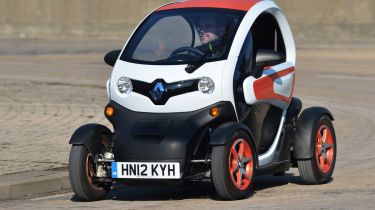Renault Twizy Technic
Unconventional design and cheap price are the Twizy’s trump cards
If you get the chance, it’s worth driving a Twizy just to see how much attention it generates. However, owning one demands too many compromises. A basic layout and limited weather protection mean it makes more sense in warmer climates, while the limited range will keep you within the city, where the punishingly hard ride soon becomes tiresome.
While the compact design of the Smart ForTwo has become a familiar sight on UK roads, the Renault Twizy is still a relative rarity, thanks to its limited range and basic weather protection. The narrow track and tall roof mean it looks like a four-wheeled photo booth, and it falls somewhere between a scooter and a city car in terms of size.
However, these unusual looks mean the Twizy draws a crowd faster than a six-figure supercar, and you don’t even have to go for the crazy optional colour schemes to achieve this. Everywhere we went, cameraphones clicked away and passers-by stopped to comment. You need a pretty thick skin to cope with the attention, as the silent running means you hear every gasp and laugh that the Twizy creates.
That thick skin will help protect you from the elements, too. The doors and plastic windows of the car in our test cost an extra £840, and while the windscreen and roof keep you dry, the cabin is draughty. The tandem seat layout means the back seat passenger faces even more of the breeze. Still, if you wear plenty of layers, as if you were riding a motorbike, it’s bearable. The cabin takes the scooter approach with its finish, as it uses weatherproof rubber and plastics throughout.
Used - available now

2023 Honda
Jazz
13,611 milesAutomaticPetrol1.5L
Cash £17,995
2023 Tesla
New Model Y
16,397 milesAutomaticElectric
Cash £29,750
2020 Toyota
Yaris Hybrid
21,949 milesAutomaticPetrol1.5L
Cash £13,495
2022 Volvo
XC40
35,708 milesAutomaticPetrol1.5L
Cash £27,700Driving the Twizy is unlike anything else on the road, as it mixes the central seating position and exposed nature of a scooter with the controls of a conventional car. The gearbox is operated via push buttons on the dash, and the handbrake is activated by a lever underneath the steering column.
Engage Drive, and unlike the Smart, there’s no creep from the electric drivetrain, so low-speed manoeuvres are tricky, as you have to gently tickle the accelerator to get the Twizy moving. The unassisted steering is also heavy at a standstill, although it’s fine when you’re on the move, and it has a tight turning circle.
While the Renault is tall and narrow, it carries most of its kerbweight low down between the wheels, so it has plenty of grip and hardly any body roll, thanks to its stiff suspension. But that firm set-up means the ride is uncomfortable. Even the smallest bumps lead to shudders through the cabin, and big bumps can send you flying out of the seat. Add in the whining electric drivetrain, as well as the constant buffeting, and the Twizy can very quickly become tiresome to drive.
Not that you’ll be driving it for long periods. Renault claims a 62-mile range, but admits 50 miles is more realistic – nearly half that of the Smart. But it takes only three-and-a-half hours to charge the battery from a standard socket.
With a list price of £7,495, even the top-spec Twizy Technic tested here costs around half as much to buy as the cheapest ForTwo. As with Smart, Renault offers a battery hire scheme with the Twizy. Plans are tailored to individual use, but prices start from £45 a month, and Renault guarantees the amount of charge the batteries will hold.
Do the cost savings make sense when you have to compromise so heavily in other areas?







